Salonen conducts Sibelius, RFH/Oramo conducts Salonen, Barbican review - Finnish psychedelia | reviews, news & interviews
Salonen conducts Sibelius, RFH/Oramo conducts Salonen, Barbican review - Finnish psychedelia
Salonen conducts Sibelius, RFH/Oramo conducts Salonen, Barbican review - Finnish psychedelia
A colouristic master excels as composer and - eventually - as conductor
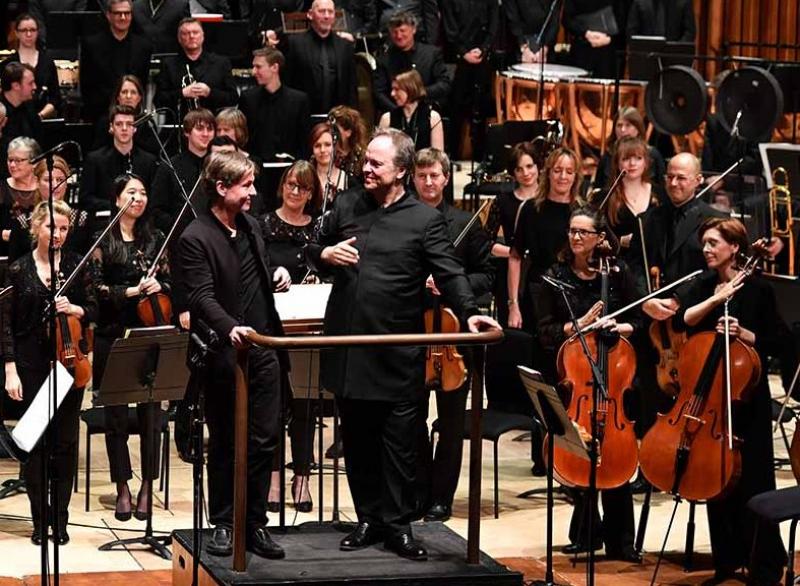
After Sakari Oramo's dazzling Sibelius rattlebag with the BBC Symphony Orchestra on the centenary day of Finnish independence, things weren't looking so good for Esa-Pekka Salonen and the Philharmonia at half time last Thursday (★★★).
Though there's a density about Salonen's later orchestral writing, moving in an opposite direction to Sibelius's compression, which seemed backdated here even to Mimo II for oboe and anything but the advertised "small orchestra," the quartet of Salonen specials offered exuberant variety, from siren high-soprano duets to the full chorus of a Dadaist incantation. Unlike too many contemporary composers, Salonen isn't hung up on process at the expense of hooks in the form of arresting foreground ideas. No need to fall back on "soundworld" tags here: like the monster three-parters of John Adams, the score always gives the impression of moving through time and space – and like Adams, though with even more of a debt to the sensuality of Debussy, Ravel and Messiaen, he's not afraid of being thought what an uptight British-establishment sensibility might call vulgar. 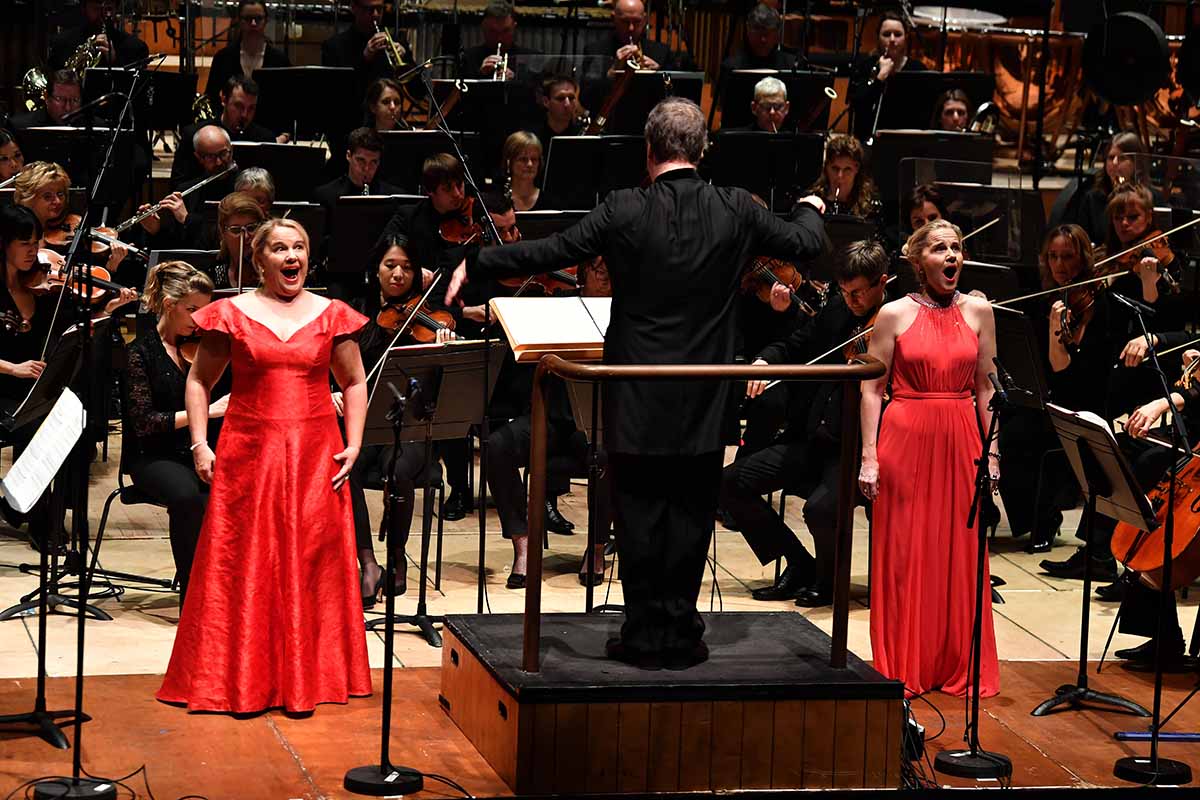 Attractive woodwind riffs bubble up through the curtain-raiser Gambit, and the writing for the phenomenal Komsi twins, Anu (Mrs Oramo) and Piia in Wing on Wing (pictured above with Oramo and the BBCSO), previously heard performing the work in the same hall over a decade ago, never repeats the opening siren-like formula for them as they move around the hall. It would be hard to imagine this half-hour extravaganza without them; anyone resistant to the confrontational glamour of the piece would still have to make obeisance to their luminous blend of the vocal and the instrumental, and on this occasion the superb young oboist now within the ranks of the BBCSO, Tom Blomfield, returned the compliment. It was difficult in Salonen's high-wire writing for him to tell where the oboe part ended and the sopranos took over.
Attractive woodwind riffs bubble up through the curtain-raiser Gambit, and the writing for the phenomenal Komsi twins, Anu (Mrs Oramo) and Piia in Wing on Wing (pictured above with Oramo and the BBCSO), previously heard performing the work in the same hall over a decade ago, never repeats the opening siren-like formula for them as they move around the hall. It would be hard to imagine this half-hour extravaganza without them; anyone resistant to the confrontational glamour of the piece would still have to make obeisance to their luminous blend of the vocal and the instrumental, and on this occasion the superb young oboist now within the ranks of the BBCSO, Tom Blomfield, returned the compliment. It was difficult in Salonen's high-wire writing for him to tell where the oboe part ended and the sopranos took over.
The very concept of Wing on Wing shows Salonen's fertile mind working on several levels: noting its origin as an inaugural work for the LA Phil's first season at Walt Disney Concert Hall, premiered in 2004, he notes how architect Frank Gehry described one view of the new hall in the metaphor of the title, the "beautiful constellation...when a sail boat opens both the foresail and the main sail to a 180 degree angle to produce the maximum amount of sail area". The oceanic possibilities bring in the "weird sound" of a Californian fish, the plainfin midshipman, recorded and played – as Salonen told us in the first of two engaging and natural introductions – a third lower, along with the sampled voice of Gehry himself. The music is viscerally marine at times, but there's also a Sibelius-like tempest and a very earthy, joyous dance. The waves of ideas keep the listener enthralled. Salonen never forgot that he was writing for an LA audience which wanted to be entertained, and the same applies to concertgoers worldwide.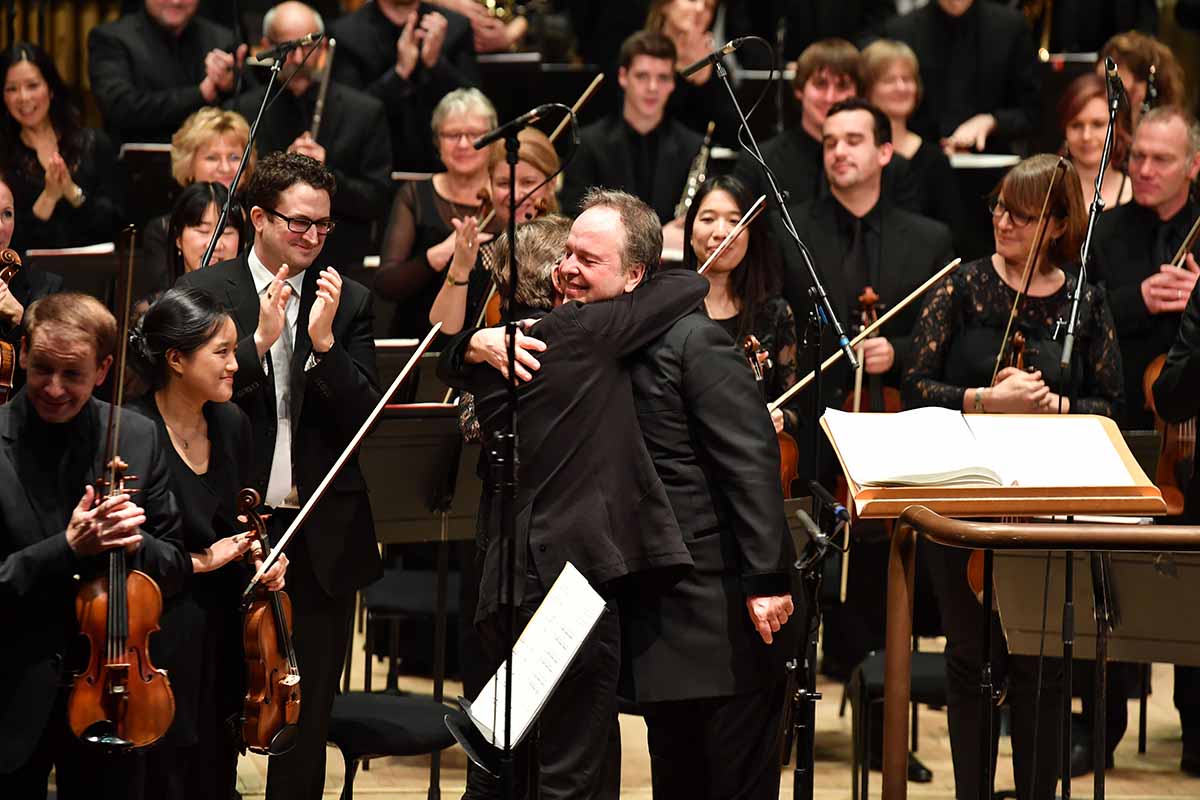 What fun, too, the BBC Symphony Chorus must have had singing and chattering their way through Karawane, to a text by Dada founder Hugo Ball. Again, Salonen's thoughts worked on the theme - intended for Zurich, where the Dada movement was born, enriched by taking a cue from the opening word "jolifanto" to suggest "a convoy of heavy animals, jolifants - a travelling circus, most likely," and finding a cyclical form in the idea of the procession moving on, but seen from a different angle in Part Two, ascending and descending Escher's never-ending staircase. Even a Balinese chant, the kecak, adds to the riches.
What fun, too, the BBC Symphony Chorus must have had singing and chattering their way through Karawane, to a text by Dada founder Hugo Ball. Again, Salonen's thoughts worked on the theme - intended for Zurich, where the Dada movement was born, enriched by taking a cue from the opening word "jolifanto" to suggest "a convoy of heavy animals, jolifants - a travelling circus, most likely," and finding a cyclical form in the idea of the procession moving on, but seen from a different angle in Part Two, ascending and descending Escher's never-ending staircase. Even a Balinese chant, the kecak, adds to the riches.
There's the usual Salonen layering in the beautiful nocturne dominated by solo cello (Susan Monks) and oboe, and the expected rhythmic fireworks in explosions which take the Assyrian incantation of Prokofiev's Seven, They Are Seven several notches higher; the BBCSC sopranos made brilliant work of their ecstatic unisons. And Oramo's tireless focused energy with the rhythms must have impressed his fellow conductor. Three weeks ago Austrian composer HK Gruber in Stockholm said he'd never heard his works so well conducted as by Oramo, not even by himself; I wonder if Salonen would say the same.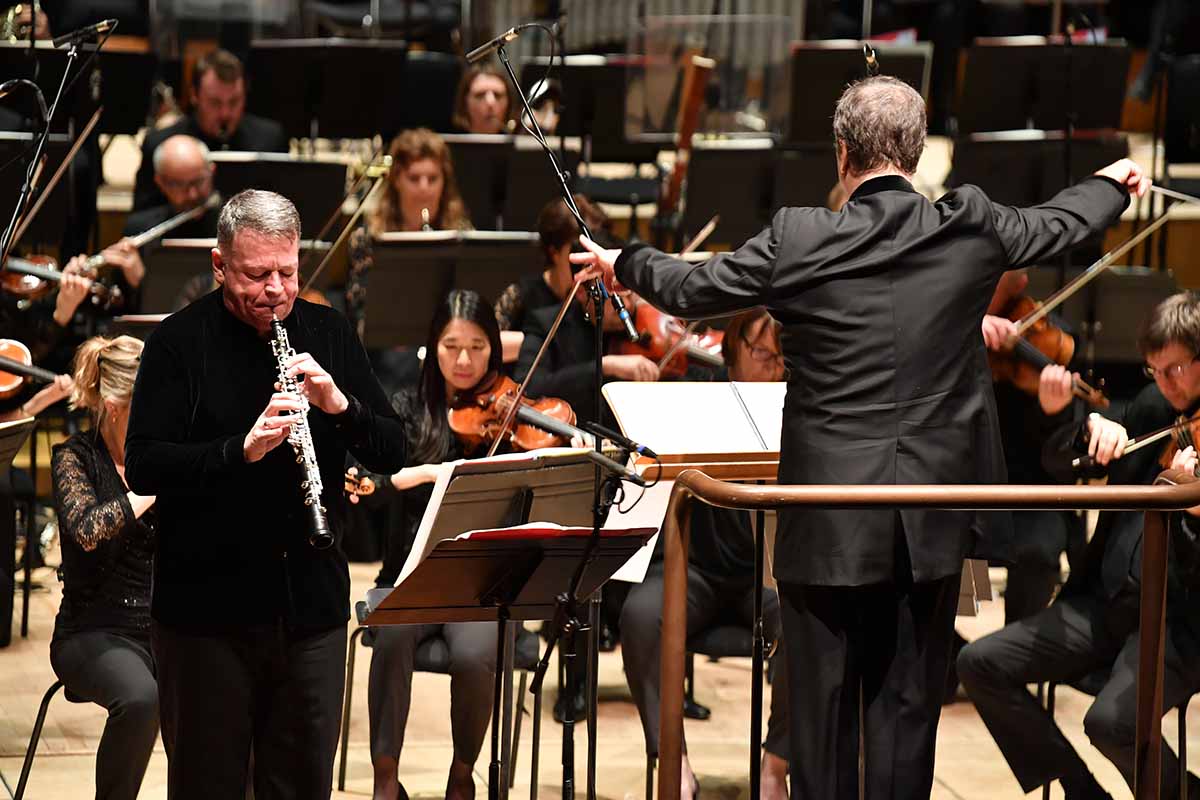 Perfect consonance between soloist, conductor and orchestra made the brief but dramatically varied Mimo II as much of a wonder as anything else in the programme; from orchestral oboe to the foreground power of the great Nicholas Daniel (pictured above with Oramo and the BBCSO) made this the icing on the cake. Salonen always writes melodically and gratefully for the soloist in a series of seven closely related melodies - not quite a theme and variations, a complex one I'd like to hear again; only towards the end does the orchestra try to take over.
Perfect consonance between soloist, conductor and orchestra made the brief but dramatically varied Mimo II as much of a wonder as anything else in the programme; from orchestral oboe to the foreground power of the great Nicholas Daniel (pictured above with Oramo and the BBCSO) made this the icing on the cake. Salonen always writes melodically and gratefully for the soloist in a series of seven closely related melodies - not quite a theme and variations, a complex one I'd like to hear again; only towards the end does the orchestra try to take over.
Unfortunately Salonen's partnership with his soloist last Thursday didn't work nearly so well. After an over-grandiose Finlandia, well played but excitement-wise not a patch on the original version Oramo espoused in the Finnish Independence Day concert, and with tricksy lighting effects which dogged the whole concert, Vilde Frang was the soloist in the Sibelius Violin Concerto. She's an imaginative and original player, as her intent in playing the opening spell without vibrato at first announced, against the quietest possible background of violins; but she was playing one work, a forward-moving drama, and the orchestra another. They seemed to hold her back; this was a classic concerto misalliance. 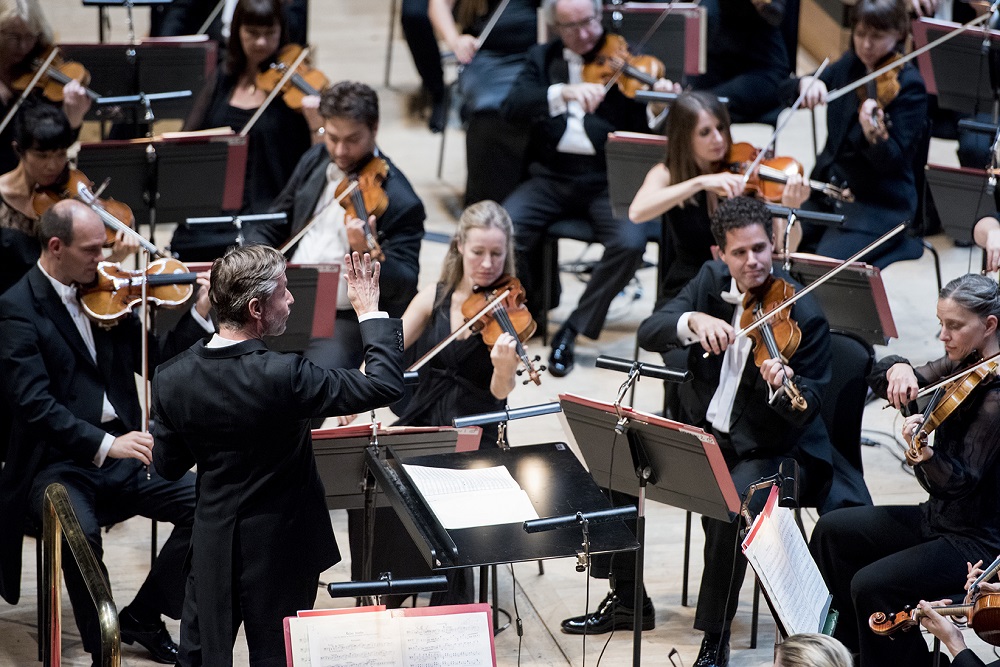 There was no reason, though, why Salonen's Lemminkäinen interpretation should disappoint (as conductor, pictured above with the Philharmonia by Camilla Greenwell); he conducted the Philharmonia in it absolutely brilliantly seven years ago. Initial worries that some details, like the drone bass as the Kalevala hero embarks on his wooing of the Saari maidens, might be over-spotlit, dissolved as Salonen masterfully unfurled the Tristanesque love theme. The icy walls of the Finnish mythological Hades towered frighteningly in ever mounting waves through "Lemminkäinen in Tuonela," while the bitterly sad swan song, wisely placed third in the sequence, sounded at first from a distance in Jill Crowther's subtle vocalising through misty layers. What a deep level of inspiration Sibelius plumbs throughout, hallucinogenic in this performance. And to round off the elliptical tour de force that is "Lemminkäinen's Homecoming," Salonen got the basses to slap their bows on wood as you never heard the effect before. Always fine-tuned to extraordinary sounds, he can be as remarkable a conductor as he is a composer.
There was no reason, though, why Salonen's Lemminkäinen interpretation should disappoint (as conductor, pictured above with the Philharmonia by Camilla Greenwell); he conducted the Philharmonia in it absolutely brilliantly seven years ago. Initial worries that some details, like the drone bass as the Kalevala hero embarks on his wooing of the Saari maidens, might be over-spotlit, dissolved as Salonen masterfully unfurled the Tristanesque love theme. The icy walls of the Finnish mythological Hades towered frighteningly in ever mounting waves through "Lemminkäinen in Tuonela," while the bitterly sad swan song, wisely placed third in the sequence, sounded at first from a distance in Jill Crowther's subtle vocalising through misty layers. What a deep level of inspiration Sibelius plumbs throughout, hallucinogenic in this performance. And to round off the elliptical tour de force that is "Lemminkäinen's Homecoming," Salonen got the basses to slap their bows on wood as you never heard the effect before. Always fine-tuned to extraordinary sounds, he can be as remarkable a conductor as he is a composer.
- Read more classical reviews on theartsdesk
- BBCSO/Oramo Salonen concert to be broadcast on BBC Radio 3 on 3 January 2018
Explore topics
Share this article
The future of Arts Journalism
You can stop theartsdesk.com closing!
We urgently need financing to survive. Our fundraising drive has thus far raised £33,000 but we need to reach £100,000 or we will be forced to close. Please contribute here: https://gofund.me/c3f6033d
And if you can forward this information to anyone who might assist, we’d be grateful.

Subscribe to theartsdesk.com
Thank you for continuing to read our work on theartsdesk.com. For unlimited access to every article in its entirety, including our archive of more than 15,000 pieces, we're asking for £5 per month or £40 per year. We feel it's a very good deal, and hope you do too.
To take a subscription now simply click here.
And if you're looking for that extra gift for a friend or family member, why not treat them to a theartsdesk.com gift subscription?
more Classical music
 Bavouzet, BBCSO, Stasevska, Barbican review - ardent souls in mythic magic
Vivid realisation of fantastical masterpieces by Bartók, Ravel and Janáček
Bavouzet, BBCSO, Stasevska, Barbican review - ardent souls in mythic magic
Vivid realisation of fantastical masterpieces by Bartók, Ravel and Janáček
 Levit, Budapest Festival Orchestra, Fischer, RFH review - anger unleashed, fantasy finessed in Prokofiev
Instant communication from Berlin-based pianist and Hungarian army of generals
Levit, Budapest Festival Orchestra, Fischer, RFH review - anger unleashed, fantasy finessed in Prokofiev
Instant communication from Berlin-based pianist and Hungarian army of generals
 A Form of Exile: Edward Said and Late Style, CLS, Wood, QEH review - baggy ferment of ideas and sounds
Superlative actors and musicians in an over-ambitious event running to three hours
A Form of Exile: Edward Said and Late Style, CLS, Wood, QEH review - baggy ferment of ideas and sounds
Superlative actors and musicians in an over-ambitious event running to three hours
 BBC Philharmonic, Bihlmaier, Bridgewater Hall, Manchester review - an International Women's Day special
Spotlight on today’s composers and one of their sisters from the past
BBC Philharmonic, Bihlmaier, Bridgewater Hall, Manchester review - an International Women's Day special
Spotlight on today’s composers and one of their sisters from the past
 Sheku Kanneh-Mason, Czech Philharmonic, Bychkov, Barbican review - from Russia, with tough love
Cellist, conductor and a great orchestra play Shostakovich for today
Sheku Kanneh-Mason, Czech Philharmonic, Bychkov, Barbican review - from Russia, with tough love
Cellist, conductor and a great orchestra play Shostakovich for today
 Classical CDs: Funeral marches, festivals and film noir
Choral music, solo piano recitals and the best violin concerto you've never heard
Classical CDs: Funeral marches, festivals and film noir
Choral music, solo piano recitals and the best violin concerto you've never heard
 Mahan Esfahani, Wigmore Hall review - shimmering poise and radical brilliance
Magnificent demonstration of a lifelong dedication to the harpsichord
Mahan Esfahani, Wigmore Hall review - shimmering poise and radical brilliance
Magnificent demonstration of a lifelong dedication to the harpsichord
 Gromes, Hallé, Chauhan, Bridgewater Hall, Manchester review - new concerto and music of triumph
Spirit of Germany in the 1930s captured in Herz’s tense and despondent work
Gromes, Hallé, Chauhan, Bridgewater Hall, Manchester review - new concerto and music of triumph
Spirit of Germany in the 1930s captured in Herz’s tense and despondent work
 Helen Charlston, Sholto Kynoch, Temple Church review - fine singing, powerful stage presence
Coups de théâtre in a well-constructed programme
Helen Charlston, Sholto Kynoch, Temple Church review - fine singing, powerful stage presence
Coups de théâtre in a well-constructed programme
 Ridout, 12 Ensemble, Wigmore Hall review - brilliant Britten and bombastic Brahms
Dazzling solo and ensemble playing in pieces inspired by music of the past
Ridout, 12 Ensemble, Wigmore Hall review - brilliant Britten and bombastic Brahms
Dazzling solo and ensemble playing in pieces inspired by music of the past
 Argerich, Oxford Philharmonic Orchestra, Papadopoulos, Barbican review - the great pianist as life and soul
Her delivery of the Beethoven made it clear that she still merits legend status
Argerich, Oxford Philharmonic Orchestra, Papadopoulos, Barbican review - the great pianist as life and soul
Her delivery of the Beethoven made it clear that she still merits legend status
 Jessica Duchen: Myra Hess - National Treasure review - well-told life of a pioneering musician
Biography of the groundbreaking British pianist who was a hero of the Blitz
Jessica Duchen: Myra Hess - National Treasure review - well-told life of a pioneering musician
Biography of the groundbreaking British pianist who was a hero of the Blitz

Add comment